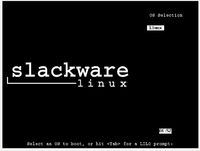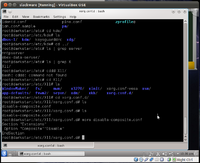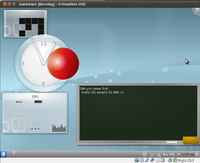COMP 3000 2011 Report: Slackware 13.37
Background
The Slackware linux project was founded and is coordinated by Patrick Volkerding with the aim to be the most UNIX-like Linux distribution available. In its creation two key tenants are followed, ease of use and stability, resulting in a very flexible and easily maintainable OS. Slackware is based on the 2.6 Linux kernel series and uses the GNU C library version 2.7. For more information or to obtain Slackware visit www.slackware.com to order a DVD or download the ISO<ref name="slack">Patrick Volkerding. "." The Slackware Linux Project. 2011-04-27. . 16 October 2011. <http://www.slackware.com>.</ref>.
Installation/Startup
Installation of Slackware Linux was fairly straightforward with complete and clear directions to getting up and running. Installing it through Virtualbox with Ubuntu 11.04 as a host OS presented no particular problems, though may have caused some operational issues that I'll address later. Loading up the slackware.iso brought up a prompt screen that allowed for additional commands to be entered prior to boot (though not required). Then logging in as root and after being prompted to create a partition with fdisk or cfdisk, Slackware provided guidance though its setup utility (called through 'setup') allowing for highly customizable package installation for various different uses, here the default installation was used. After installation, a short configuration and restart was able to login as root but encountered a problem starting the KDE X server, Some research provided a fix<ref name="fix">disturbed1. "KDE crashes in Slackware 13.37" 06-08-2011. LinuxQuestions.org. 16 October 2011. http://www.linuxquestions.org/questions/slackware-14/kde-crashes-in-slackware-13-37-a-885306/</ref> of disabling composites after which was able to startx without it crashing. though current setup does not startx on boot.
Basic Operation
Slackware Linux is a general distribution optimized for ease of use and stability allowing it to be customized for many different possible roles with the default installation providing a fairly standard OS with a mix of pre-loaded preloaded programs from compilers to games. Shell operation was much the same as other distributions, operation in x windows became a bit sluggish but that could have been accounted for from the virtualization settings. Kde allowed for widgets to be loaded on the desktop and allowed for multiple toolbars or 'panels'. Never got a network connection running and not sure if that was the result of virtualization or not digging hard enough into network settings.
Usage Evaluation
Slackware attempts to be easy to use and stable. For ease of use Slackware provided ample guidance during setup and installation and the GUI environment was fairly easy to navigate and use though there were instances where it was unclear what an icon would do when clicked as there was no label or tooltip. As for stability there where some initial issues with KDE crashing and some other services that did not startup properly. though some were solved with a bit of research and quite possibly the others just required a bit of missing configuration to work properly. So there was some issues but they were easily solvable. Though stability most likely refers more to following Linux standards and conventions then how often it crashes. Definitely Felt like a true Linux experience though. Overall its strength is not in its default form but in it flexibility to perform many different roles, weather as a terminal or server and in that it seems to excel though further evaluation may be required to state definitively. Overall though is fairly easy to use is more suited to a more adventurous and technically inclined person than the average user.
References
<references/>




